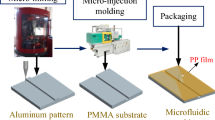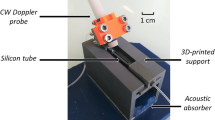Abstract
The behaviour of blood flow in relation to microchannel surface roughness has been investigated. Special attention was focused on the techniques used to fabricate the microchannels and on the apparent viscosity of the blood as it flowed through these microchannels. For the experimental comparison of smooth and rough surface channels, each channel was designed to be 10 mm long and rectangular in cross-section with aspect ratios of ≥100:1 for channel heights of 50 and 100 μm. Polycarbonate was used as the material for the device construction. The shims, which created the heights of the channels, were made of polyethylene terephthalate. Surface roughnesses of the channels were varied from R z of 60 nm to 1.8 μm. Whole horse blood and filtered water were used as the test fluids and differential pressures ranged from 200 to 5,000 Pa. The defibrinated horse blood was treated further to prevent coagulation. The results indicate that a surface roughness above an unknown value lowers the apparent viscosity of blood dramatically due to boundary effects. Furthermore, the roughness seemed to influence both water and whole blood almost equally. A set of design rules for channel fabrication is also presented in accordance with the experiments performed.




Similar content being viewed by others
References
Baskurt OK, Farley RA, Meiselman HJ (1997) Erythrocyte aggregation tendency and cellular properties in horse, human and rat: a comparative study. Am J Physiol (Heart Circ Physiol) 273(6):H2604–H2612
Choi H, Westin KJA, Breuer KS (2002) To slip or not to slip—water flows in hydrophilic and hydrophobic walls. In: Proceedings of the international mechanical engineering conference and exposition, 13–16 November 2002, New Orleans, Louisiana, USA, IMECE2002-33707, pp 1–8
Cohen DS, Feaster SR (2007) Rough channel microfluidic devices. United States Patent Application Publication No. US 2007/0140913 A1, 21 June 2007
Gardner RS, Chong KS, Morton JJ, McDonagh TA (2007) A change in N-terminal pro-brain natriuretic peptide is predictive of outcome in patients with advanced heart failure. Eur J Heart Fail 9(3):266–271
Hill MD (2005) Diagnostic biomarkers for stroke: a stroke neurologist’s perspective. Clin Chem 51(11):2001–2002
Hodes M, Enright R, Eason C, Dalton T, Kolodner P, Salamon T, Krupenkin T (2006) Friction factors and Nusselt numbers in microchannels with superhydrophobic walls. In: Proceedings of the fourth international conference on nanochannels, microchannels and minichannels, 19–21 June 2006, Limerick, Ireland, ICNMM2006-96134, pp 1–11
Jain NC (1993) Essentials of veterinary hematology, chap 2. Blackwell Publishing, Oxford
Kulkarni AS (2004) Effects of surface roughness in microchannel flows. M.Sc. thesis, University of Florida
Lima R (2008) In vitro blood flow in a rectangular PDMS microchannel: experimental observations using a confocal micro-PIV system. Biomed Microdevices 10:153–167
Marson S, Evans R, Allen DM (2007) Replication of polymer microcomponents: the economics of hot embossing versus injection moulding. In: Proceedings of the 20th international conference on computer-aided production engineering (CAPE 2007), Glasgow, 6th–8th June 2007, Keynote paper, pp 2–11
Merrill EW, Gilliland ER, Cokelet G, Shin H, Britten A, Wells RE (1963) Rheology of human blood near and at zero flow, effects of temperature and hematocrit level. Biophys J 3:199–213
Sharan M, Popel AS (2001) A two-phase model for flow of blood in narrow tubes with increased effective viscosity near the wall. Biorheology 38:415–428
Tipler PA, Mosca G (2004) Physik: für Wissenschaftler und Ingenieure. (Physics: for scientists and engineers) (2nd German edn). Elsevier GmbH/Spektrum Akademischer Verlag, Heidelberg, pp 392–417
Tüdos AJ, Besselink GAJ, Schasfoort RBM (2001) Trends in miniaturised total analysis systems for point-of-care testing in clinical chemistry. Lab Chip 1:83–95
Vand V (1948) Viscosity of solutions and suspensions II. J Phys Colloid Chem 52:300–314
Wang H, Wang Y (2007) Flow in microchannels with rough walls: flow pattern and pressure drop. J Micromech Microeng 17:586–596
Acknowledgments
D.M.A. wishes to thank EPSRC for Grand Challenge grant EP/C534212/1 to research “The design and manufacture of 3D-miniaturised integrated products” (“3D-Mintegration”). S.P. wishes to thank Kaiserslautern University of Applied Sciences for funding to carry out his research at Cranfield University.
Author information
Authors and Affiliations
Corresponding author
Additional information
Originally presented at the DTIP 2009, Rome
Rights and permissions
About this article
Cite this article
Prentner, S., Allen, D.M., Larcombe, L. et al. Effects of channel surface finish on blood flow in microfluidic devices. Microsyst Technol 16, 1091–1096 (2010). https://doi.org/10.1007/s00542-009-1004-1
Received:
Accepted:
Published:
Issue Date:
DOI: https://doi.org/10.1007/s00542-009-1004-1




